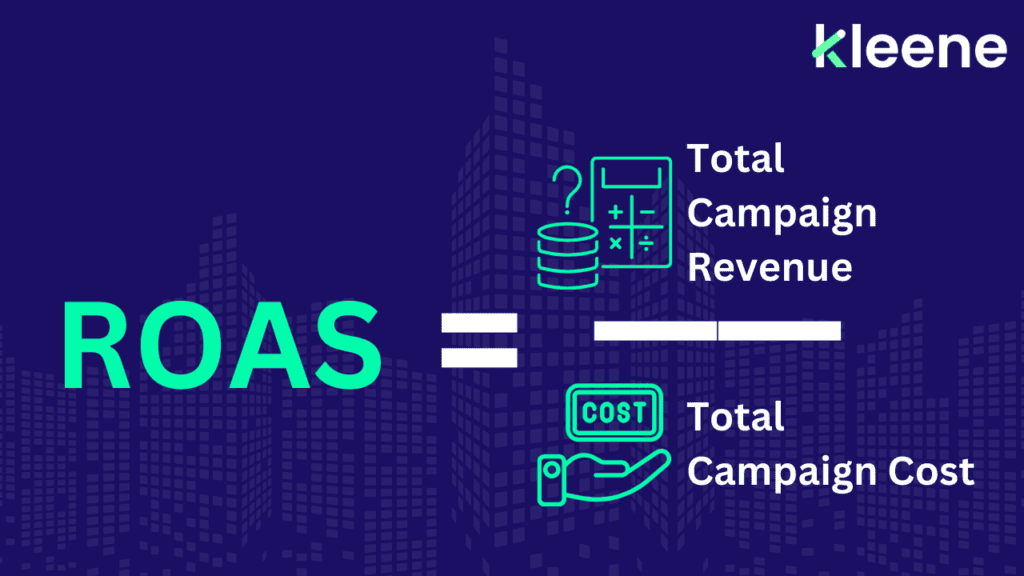Introduction
Understanding how to calculate ROAS (Return on Advertising Spend) is crucial for any business aiming to optimize its marketing strategies. The ROAS formula is a key metric that helps businesses measure the effectiveness of their advertising campaigns. In this comprehensive guide, we will explore the ROAS formula, its importance, and how to leverage it to improve your marketing spend. We will also address frequently searched questions related to ROAS and provide insights into why black box solutions don’t work, the necessity of full-channel measuring tools, and the importance of predictive models.
What is ROAS?
ROAS stands for Return on Advertising Spend. It is a marketing metric that measures the revenue generated for every dollar spent on advertising. The ROAS formula is simple:

Using this formula allows businesses to assess the performance of their advertising campaigns and make informed decisions about where to allocate their marketing budget.
Why the ROAS Formula is Essential
The ROAS formula provides valuable insights into the efficiency of your advertising efforts. By calculating ROAS, you can determine which campaigns are delivering the best returns and which ones need improvement. This metric helps businesses:
- Evaluate Campaign Performance: Understand which ads are driving the most revenue.
- Optimize Budget Allocation: Allocate more budget to high-performing campaigns.
- Improve Marketing Strategies: Identify areas for improvement and adjust strategies accordingly.
- Measure ROI: Gain a clear picture of the return on investment from your advertising spend.
7 Key Strategies to Maximize Advertising Returns with the ROAS Formula
- Evaluate Campaign Performance: Use the ROAS formula to determine which ads are driving the most revenue. By assessing individual campaign performance, you can identify successful strategies and areas needing improvement.
- Optimize Budget Allocation: Allocate more budget to high-performing campaigns based on their ROAS. The ROAS formula helps you understand which campaigns offer the best return, enabling you to invest more effectively.
- Enhance Ad Targeting: Refine your ad targeting to ensure that your ads reach the right audience. By improving targeting, you can increase the effectiveness of your ads and achieve a better ROAS.
- Improve Ad Creatives: Create compelling and relevant ad content that resonates with your audience. Better ad creatives can lead to higher engagement and improved ROAS.
- Utilize A/B Testing: Test different ad variations to find the most effective ones. A/B testing helps you determine which ads perform best, allowing you to optimize your campaigns for better ROAS.
- Refine Bidding Strategies: Adjust your bidding strategies based on performance data. By refining your bids, you can enhance the efficiency of your ad spend and achieve a higher ROAS.
- Use Cohorted Data for Accurate Attribution: Track revenue generated from specific customer cohorts to understand the true impact of your advertising spend. Cohorted data helps in accurately calculating ROAS by considering the time lag between ad exposure and revenue generation.

Timing of ROAS Calculation: The Importance of Cohorted Data
When calculating ROAS, it’s important to consider the timing of revenue generation. Different advertising campaigns can have varying lag times between the ad spend and the resulting revenue. This is where cohorted data becomes essential.
What is Cohorted Data?
Cohorted data groups customers based on a shared characteristic within a specific timeframe, such as the month they first interacted with your ad. By using cohorted data, you can more accurately attribute revenue to the corresponding advertising spend.
Why Use Cohorted Data for ROAS?
- Improved Accuracy: Cohorted data provides a clearer picture of how long it takes for an advertising campaign to generate revenue.
- Better Insights: It helps in understanding customer behavior and the time lag between ad exposure and conversion.
- Enhanced Decision-Making: With more accurate data, businesses can make better-informed decisions about future ad spend and strategy adjustments.
How to Calculate Cohorted ROAS
- Define the Cohort: Determine the period during which the customers were exposed to the advertising campaign.
- Track Revenue Over Time: Measure the revenue generated from these customers over a defined period, such as 30, 60, or 90 days.
- Apply the ROAS Formula: Divide the revenue from the cohort by the advertising spend during the same period.
For example, if you spent £5,000 on advertising in January and the customers acquired in January generated £20,000 in revenue by the end of March, your cohorted ROAS would be:
Cohorted ROAS=£20,000/£5,000=4
This means that for every pound spent on advertising in January, you earned £4 in revenue by the end of March.
Why Black Box Solutions Don’t Work
Black box solutions are pre-packaged tools that offer limited customization and transparency. While they may seem convenient, they often fall short in providing accurate measurements tailored to your unique business needs. Here’s why:
- Lack of Customization: Black box solutions are designed to be one-size-fits-all, which means they might not address specific nuances of your business.
- Limited Transparency: These solutions often do not provide insights into how their algorithms work, making it difficult to trust their accuracy.
- Inflexibility: They may not adapt to changes in your business model or market conditions.
The Necessity of Full-Channel Measuring Tools
Without full-channel measuring tools, companies struggle to measure brand spending accurately and understand how to allocate resources efficiently. These tools are crucial because:
- Holistic View: They provide a comprehensive view of all marketing channels, both online and offline.
- Accurate Attribution: They help in accurately attributing revenue to the correct channels.
- Resource Allocation: They enable better decision-making regarding where to allocate marketing budgets.
Importance of Marketing Spend Optimization Tools
Marketing spend optimization tools are essential for maximizing the effectiveness of your advertising campaigns. These tools offer:
- Channel Impact Measurement: They measure the impact of each marketing channel on your overall performance.
- Predictive Modelling: They use predictive models to forecast the impact of budget shifts on ROAS, Customer Acquisition Cost (CAC), and Lifetime Value (LTV).
- Strategic Allocation: They enable more strategic allocation decisions by providing insights into potential future outcomes.

Comprehensive Measurement Tools
To accurately calculate or predict ROAS, you need a measurement tool that uses an algorithm considering all touchpoints, including both offline and online. These tools should offer:
- Integrated Data: Combining data from various sources to provide a unified view.
- Advanced Attribution Models: Using models that consider multiple touchpoints in the customer journey.
- Real-Time Insights: Providing real-time data to make timely adjustments.
Conclusion
Calculating ROAS using the ROAS formula is essential for any business looking to optimize its marketing spend. By understanding and applying the ROAS formula, businesses can make more informed decisions about their advertising strategies. Remember, black box solutions are not sufficient for accurate measurement. Instead, opt for full-channel measuring tools and marketing spend optimization tools that use advanced algorithms and predictive models. These tools will help you measure the impact of each channel, forecast the impact of budget shifts, and ultimately, improve your ROAS.
By following the insights and strategies outlined in this guide, you can ensure that your advertising efforts are not only effective but also efficient, leading to better returns on your marketing investments.
Next Steps for increasing ROAS
Integrating cutting-edge technological platforms, such as Kleene’s Decision Intelligence Platform, can make it easier for Chief Marketing Officers to implement Marketing Mix Modelling and ensure ROI.
By streamlining the implementation of Marketing Mix Modelling , our platform enables Marketing teams to access deeper insights more efficiently and effortlessly. This efficiency is achieved through:
- Comprehensive Data Integration: Our platform excels in aggregating a wide array of data sources, including sales, marketing, consumer behaviour analytics, finance, and logistics. This extensive integration facilitates a more thorough and accurate analysis.
- Holistic Campaign Analysis: The platform is adept at measuring the impact of both online and offline campaigns, ensuring a comprehensive view of marketing efforts. Enhanced Insights from Comprehensive Data: with the inclusion of diverse data sets, the platform provides richer insights, enabling more informed decision-making
- User-Friendly Interface: Kleene’s platform is designed with user experience in mind, allowing CMOs and their teams to navigate complex data analytics with ease. This simplifies the process of deriving actionable insights from MMM results.
- Exceptional Support and Expertise: Kleene partners with clients to ensure a significant return on investment and effective implementation of the platform, providing unparalleled support and expertise.
Contact a Kleene.ai data expert to learn more about how their Decision Intelligence Platform can help your company get a better ROAS
You may also:
Return on Ad Spend: 10 Proven Strategies to Maximize
7 Powerful Tips on How to Work Out ROAS Accurately
The Ultimate Guide to ROAS Marketing: 7 Powerful Tips to Master ROAS
How to Calculate ROAS in 2024: A Comprehensive Guide to Maximising Your Return on Ad Spend
Frequently Asked Questions (FAQ)
1. What is ROAS?
ROAS stands for Return on Advertising Spend. It is a metric that measures the revenue generated for every dollar spent on advertising. The ROAS formula is:
2. What is a good ROAS?
A good ROAS varies by industry and business goals. A common benchmark is a ROAS of 4:1, meaning you earn £4 for every £1 spent on advertising. This indicates a healthy return on investment.
3. How can I improve my ROAS using the ROAS formula?
To improve your ROAS, consider optimizing ad targeting, enhancing ad creatives, utilizing A/B testing, and refining bidding strategies, all of which can positively impact the ROAS formula outcome.
4. How do I calculate ROAS for multiple campaigns using the ROAS formula?
To calculate ROAS for multiple campaigns using the ROAS formula, follow these steps:
- Calculate Individual ROAS: Use the ROAS formula for each campaign.
- Aggregate Costs and Revenue: Sum up the total costs and revenue for all campaigns.
- Apply the ROAS Formula: Divide the total revenue by the total costs to get a comprehensive ROAS formula result.
5. What is the difference between ROAS and ROI?
ROAS measures the revenue generated from advertising spend, using the ROAS formula, while ROI (Return on Investment) measures the overall profitability of an investment. ROI considers all costs and revenues, not just those related to advertising, while ROAS focuses specifically on advertising efficiency through the ROAS formula.
6. Why should I use cohorted data for ROAS formula calculation?
Cohorted data provides a more accurate attribution of revenue to the corresponding advertising spend, considering the lag time between ad exposure and conversion. This improves the accuracy of the ROAS formula.
7. What are black box solutions?
Black box solutions are pre-packaged tools with limited customization and transparency. They often lack the accuracy and flexibility needed for tailored business needs, unlike tools that apply the ROAS formula precisely.
8. Why are full-channel measuring tools essential for the ROAS formula?
Full-channel measuring tools provide a comprehensive view of all marketing channels, allowing for accurate revenue attribution and better resource allocation using the ROAS formula.
9. What are the benefits of marketing spend optimization tools for the ROAS formula?
These tools measure the impact of each marketing channel, use predictive models to forecast budget shifts on ROAS, CAC, and LTV, and enable strategic allocation decisions, enhancing the application of the ROAS formula.
10. How do comprehensive measurement tools work for the ROAS formula?
Comprehensive measurement tools use advanced algorithms to integrate data from various sources, apply sophisticated attribution models, and provide real-time insights for accurate ROAS calculation using the ROAS formula.



